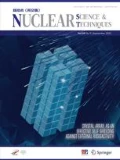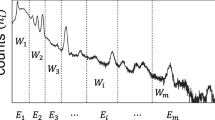Abstract
Since the room-temperature detector CdZnTe (CZT) has advantages in terms of detection efficiency, energy resolution, and size, it has been extensively used to detect X-rays and gamma-rays. So far, nuclear radiation detectors such as cerium chloride doped with lanthanum bromide (LaBr\(_3\) (Ce)), thallium doped with cesium iodide (CsI (Tl)), thallium doped with sodium iodide (NaI (Tl)), and high-purity germanium (HPGe) primarily use the spectroscopy-dose rate function (G(E)) to achieve the accurate measurement of air kerma rate (\(\dot{K}_{a}\)) and ambient dose equivalent rate (\(\dot{H}^*(10)\)). However, the spectroscopy-dose rate function has been rarely measured for a CZT detector. In this study, we performed spectrum measurement using a hemispherical CZT detector in a radiation protection standards laboratory. The spectroscopy-dose rate function G(E) of the CZT detector was calculated using the least-squares method combined with the standard dose rate at the measurement position. The results showed that the hemispherical CZT detector could complete the measurement of air kerma rate (\(\dot{K}_{a}\)) and ambient dose equivalent rate (\(\dot{H}^*\)(10)) by using the G(E) function at energies between 48 keV and 1.25 MeV, and the relative intrinsic errors were, respectively, controlled within ± 2. 3 and ± 2. 1%.








Similar content being viewed by others
References
S. Moriuchi, I. Miyanaga, A spectrometric method for measurement of low-level gamma exposure dose. Health Phys. 12, 541–551 (1966). https://doi.org/10.1097/00004032-196604000-00009
Y.Y. Ji, K.H. Chung, W. Lee et al., Feasibility on the spectrometric determination of the individual dose rate for detected gamma nuclides using the dose rate spectroscopy. Radiat. Phys. Chem. 97, 172–177 (2014). https://doi.org/10.1016/j.radphyschem.2013.11.022
Y.Y. Ji, C.J. Kim, K.H. Chung et al., In situ gamma-ray spectrometry in the environment using dose rate spectroscopy. Radiat. Phys. Chem. 119, 90–102 (2016). https://doi.org/10.1016/j.radphyschem.2015.10.001
Y.Y. Ji, K.H. Chung, C.J. Kim et al., Application of the dose rate spectroscopy to the dose-to-curie conversion method using a NaI (Tl) detector. Radiat. Phys. Chem. 106, 320–326 (2015). https://doi.org/10.1016/j.radphyschem.2014.08.009
R. Casanovas, E. Prieto, M. Salvadó, Calculation of the ambient dose equivalent H*(10) from gamma-ray spectra obtained with scintillation detectors. Appl. Radiat. Isot. 118, 154–159 (2016). https://doi.org/10.1016/j.apradiso.2016.09.001
M. Tanigaki, R. Okumura, K. Takamiya et al., Development of KURAMA-II and its operation in Fukushima. Nucl. Instrum. Methods Phys. Res. Sect. A 781, 57–64 (2015). https://doi.org/10.1016/j.nima.2015.01.086
S. Tsuda, T. Yoshida, M. Tsutsumi et al., Characteristics and verification of a car-borne survey system for dose rates in air: KURAMA-II. J. Environ. Radioact. 139, 260–265 (2015). https://doi.org/10.1016/j.jenvrad.2014.02.028
S. Tsuda, M. Tsutsumi, Calculation and verification of the spectrum. Dose conversion operator of various CsI (Tl) scintillation counters for gamma-ray. Hoken Butsuri. 47, 260–265 (2012). https://doi.org/10.5453/jhps.47.260
S. Tsuda, K. Saito, Spectrum-dose conversion operator of NaI (Tl) and CsI (Tl) scintillation detectors for air dose rate measurement in contaminated environments. J. Environ. Radioact. 166, 419–426 (2017). https://doi.org/10.1016/j.jenvrad.2016.02.008
H. Terada, E. Sakai, M. Katagiri, Spectrum-to-exposure rate conversion function of a Ge (Li) in-situ environmental gamma-ray spectrometer. IEEE Trans. Nucl. Sci. 24, 647–651 (1977). https://doi.org/10.1109/TNS.1977.4328758
H.B. Li, M.Y. Jia, R. Wu et al., Calculation of spectrum to dose conversion function of portable HPGe \(\gamma \) spectrometer. Nucl. Electron. Detect. Technol. 33, 699–704 (2013). https://doi.org/10.3969/j.issn.0258-0934.2013.06.011
C.Y. Yi, J.S. Jun, H.S. Chai et al., Measurement of ambient dose equivalent using a NaI (Tl) scintillation detector. Radiat. Prot. Dosim. 74, 273–278 (1997). https://doi.org/10.1093/oxfordjournals.rpd.a032207
M. Tsutsumi, Y. Tanimura, LaCl3(Ce) scintillation detector applications for environmental gamma-ray measurements of low to high dose rates. Nucl. Instrum. Methods Phys. Res. Sect. A. 557, 554–560 (2006). https://doi.org/10.1016/j.nima.2005.11.117
W. Chen, T. Feng, J. Liu et al., A method based on Monte Carlo simulation for the determination of the G (E) function. Radiat. Prot. Dosim. 163, 217–221 (2015). https://doi.org/10.1093/rpd/ncu145
H. Dombrowski, Area dose rate values derived from NaI or LaBr 3 spectra. Radiat. Prot. Dosim. 160, 269–276 (2014). https://doi.org/10.1093/rpd/nct349
A.V. Rybka, L.N. Davydov, I.N. Shlyakhov et al., Gamma-radiation dosimetry with semiconductor CdTe and CdZnTe detectors. Nucl. Instrum. Methods Phys. Res. Sect. A 531, 147–156 (2004). https://doi.org/10.1016/j.nima.2004.05.107
Y. Wang, W.J. Xiong, Z.P. Luo et al., Capability study of multi-function dose rate meter based on hemisphere CdZnTe detector. Atom. Energy Sci. Technol. 48, 618–622 (2014). https://doi.org/10.7538/yzk.2014.48.S0.0618
J.H. Min, Z.B. Shi, Y.B. Qian et al., Simulation of the anode structure for capacitive Frisch grid CdZnTe detectors. Nucl. Sci. Tech. 20, 46–50 (2009). https://doi.org/10.13538/j.1001-8042/nst.20.46-50
G. Zeng, S. Wei, Y. Xia et al., Design of digital nuclear signal processing system for CdZnTe detector. Nucl. Tech. 38(11), 110401 (2015). https://doi.org/10.11889/j.0253-3219.2015.hjs.38.110401. (in Chinese)
S.L. Jiang, S.Q. Jiang, M.C. Hu et al., Experimental study on radiation characteristics of CZT detector. Atom. Energy Sci. Technol. 48, 638–640 (2014). https://doi.org/10.7538/yzk.2014.48.S0.0638
L.B. Niu, Y.L. Li, L. Zhang et al., Performance simulation and structure design of Binode CdZnTe gamma-ray detector. Nucl. Sci. Tech. 25, 010406 (2014). https://doi.org/10.13538/j.1001-8042/nst.25.010406
B. Grosswendt, Conversion coefficients for calibrating individual photon dosemeters in terms of dose equivalents defined in an ICRU tissue cube and PMMA slabs. Radiat. Prot. Dosim. 32, 219–231 (1990). https://doi.org/10.1093/oxfordjournals.rpd.a080737
Author information
Authors and Affiliations
Corresponding author
Additional information
This work was supported by the National Key Scientific Instruments to Develop Dedicated (Nos. 2013YQ090811 and 2016YFF0103800).
Rights and permissions
About this article
Cite this article
Huang, P. Measurement of air kerma rate and ambient dose equivalent rate using the G(E) function with hemispherical CdZnTe detector. NUCL SCI TECH 29, 35 (2018). https://doi.org/10.1007/s41365-018-0375-3
Received:
Revised:
Accepted:
Published:
DOI: https://doi.org/10.1007/s41365-018-0375-3




